How to Use OBS Studio for Professional Video Streaming in 2025
You’re trying to break out as the next big live-streaming sensation but don’t know where to start? First things first, you must be able to produce high-quality streams. To do that, you’ll need to have high-quality screen recordings, crisp audio output, and an optimized recording path. Furthermore, the content must be good enough for high-resolution viewing in full-screen mode and on mobile devices. And how exactly can you achieve all this? By using the right recording software, of course.
Currently, OBS Studio is one of the most popular live-streaming software on the market. It supports the Real-Time Messaging Protocol and has versatile RTMP-enabled software encoders. They allow professional broadcasters to stream video directly to a media server or other destinations.
As an open-source and versatile software, OBS is widely used for its ability to integrate RTMP streaming easily, delivering high-quality, low-latency streams to various streaming platforms. The best part? OBS Studio is a free broadcasting software. It has an integrated video encoder application for encoding, mixing, and more.
If this sounds like what you’re looking for, join us as we explain how to use OBS Studio and how to master all of its settings. Furthermore, we’ll tell you how to position multiple video sources, choose the best encoder, and more. By the end, you’ll be ready to start your very own professional online stream.
We updated this article to reflect the best OBS Studio settings for the latest OBS Studio 31.0.2 version released in March 2025.
Table of Contents
- What is OBS Studio Used For?
- OBS Studio Step-by-Step Guide: How to Set Up and Start Streaming
- How to Get Started Recording with OBS Studio
- How to Add Video Sources on OBS Studio
- How to Use OBS Studio Window Capture
- How to Add Images or Text with OBS Studio
- How to Arrange Multiple Video Sources on OBS Studio
- How to Set Up OBS Studio Hotkeys
- Recommended OBS Bitrate Settings
- Choosing the Right OBS Studio Encoder Settings
- The Right Hardware Setup For Running OBS
- How to Use OBS Studio with Dacast
- Multistreaming with OBS
- Integrating OBS Studio With Zoom
- OBS Studio Video Tutorial
- Streamlabs OBS (SLOBS) vs. OBS Studio
- FAQs
- Conclusion
New to Dacast and interested to try out our RTMP streaming platform for yourself? Sign up today for a 14-day trial to test out all of our features for free. No credit card is required.
What is OBS Studio Used For?
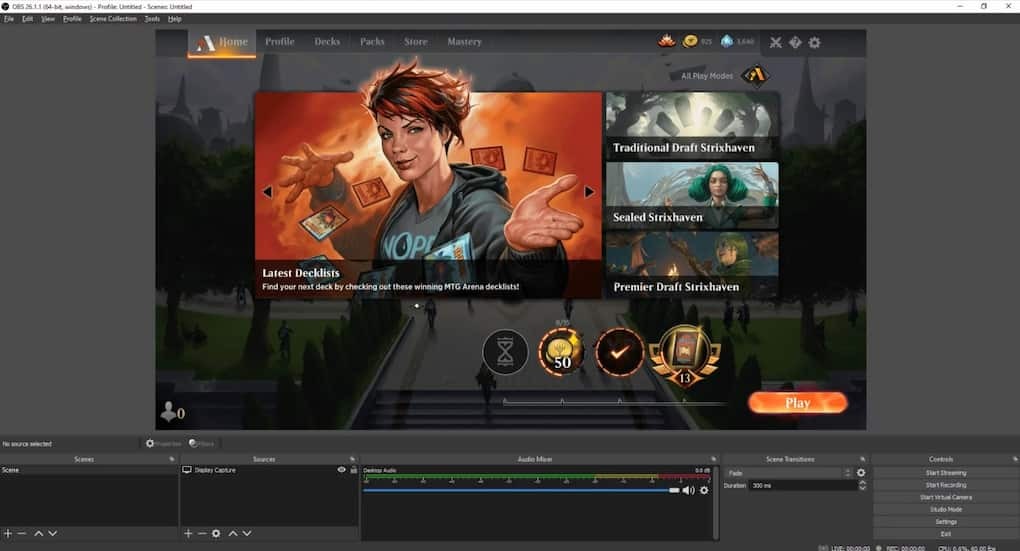

OBS Studio is a free and open-source streaming software that many broadcasters use for mixing and producing live video content. This means that unlike some paid options, you can download and use OBS Studio for free without any limitations. The latest version of OBS Studio, Version 31.0.2 was released in March 2025. It is available for macOS 11 or newer, Windows 10 and 11, as well as Ubuntu 20.04 and newer operating systems. For the Linux version, FFmpeg is required. There are many guides available online to help you install it if needed.
OBS Studio isn’t just limited to live streaming, though. It’s also a powerful tool for screen capture. If you want to record a tutorial, gameplay footage, or anything else on your screen, OBS Studio can handle it with ease.
Using OBS Studio, you can live stream your content to multiple popular streaming platforms, including YouTube, Twitch, and Facebook, to name a few. OBS lets you reach your audience wherever they choose to watch. Some of the main functions of OBS Studio are:
- Encoding
- Screen recording
- Adding text
- Adding graphic overlays
- Managing multiple stream sources
OBS operates with community-developed plugins, which you can find on the OBS Forums page. Since OBS Studio software is open-source software, we often recommend that new broadcasters use it to experiment and learn the ropes of video production.
OBS Studio Step-by-Step Guide: How to Set Up and Start Streaming
OBS Studio is a powerful open-source broadcasting and recording software. To use all of the functions of OBS Studios, you must set up OBS to flow with your streaming setup. Luckily, the OBS Auto-Configuration Wizard is available to automatically determine the proper settings for your computer and streaming solution.
This wizard is a great resource, especially for beginners new to OBS and video streaming in general. It will account for your internet upload speed, processor capabilities, and desired video quality, then recommend the best OBS settings for recording.
Even with the Auto-Configuration Wizard tool, there are a few manual configurations that you’ll need to set up to optimize OBS for streaming.
Follow these steps to set it up and start streaming or recording like a pro:
Step 1: Download and Install OBS Studio
- Visit the official OBS Studio website.
- Download the version compatible with your operating system (Windows, macOS, or Linux).
- Install OBS Studio and launch it.
Step 2: Configure Basic Settings
- When launching OBS for the first time, use the Auto-Configuration Wizard to optimize settings based on your system and internet speed.
- Manually adjust output settings under Settings > Output, choosing your desired resolution, bitrate, and encoder.
Step 3: Add Sources to Your Scene
- Create a new Scene from the “Scenes” box.
- Click + in the “Sources” box to add video sources like Display Capture, Window Capture, Game Capture, or Video Capture Device (for webcams).
- Adjust positioning and size within the preview window.
Step 4: Set Up Audio Input and Output
- Navigate to Settings > Audio to configure your microphone and desktop audio sources.
- Use the Audio Mixer panel to monitor and adjust volume levels.
Step 5: Connect to a Streaming Platform (Optional)
- Go to Settings > Stream and select your preferred streaming service (Twitch, YouTube, Facebook Live, etc.).
- Enter your Stream Key (found in your streaming account).
- Click Apply and OK to save settings.
Step 6: Adjust Scene Transitions & Overlays (Optional)
- Add professional overlays or animated transitions for a polished look.
- Configure scene transitions in the Scene Transitions panel.
Step 7: Start Streaming or Recording
- Click Start Streaming if you’re broadcasting live.
- Click Start Recording to save content locally.
Step 8: Monitor Performance & Troubleshoot
- Use the Stats panel to check CPU usage and dropped frames.
- Make necessary adjustments to improve performance.
By following these steps, you can effectively use OBS Studio for professional-quality streaming and recording.
Check out the OBS Studio Quickstart Guide for more information on how to use OBS Studio.
With that general process in mind, let’s look at how to use OBS Studio and all of its different functions for streaming. We’ll also learn how to record with OBS, add a video source, setup hotkeys, incorporate the right hardware, and more.
How to Get Started Recording with OBS Studio
Recording video content using OBS Studio is simple and highly customizable. Follow these steps to start recording efficiently:
Step 1: Set Up OBS Studio for Recording
- Open OBS Studio and create a new Scene (if you haven’t already).
- Add a Source (e.g., Display Capture, Window Capture, or Game Capture).
- Ensure your microphone and system audio are correctly set up in the Audio Mixer panel.
Step 2: Configure Output Settings
- Go to Settings > Output and set the Output Mode to “Simple” or “Advanced” (for more control over formats and bitrate).
- Choose a recording format under Recording Format (MP4, MKV, FLV, etc.).
- Set your Recording Quality (options range from high-quality file sizes to space-efficient ones).
- Select an Encoder (Software x264 for CPU-based encoding or Hardware NVENC/AMD for GPU encoding).
- Choose a Recording Path (where your recordings will be saved).
Step 3: Adjust Video and Audio Settings
- Under Settings > Video, select the Base (Canvas) Resolution and Output (Scaled) Resolution.
- Adjust the FPS (Frames Per Second) depending on the smoothness required (30 FPS for standard recording, 60 FPS for high-action content).
- In Settings > Audio, ensure the right microphone and desktop audio devices are selected.
Step 4: Start and Stop Recording
- Click Start Recording in the main OBS window.
- Perform your recording session.
- Click Stop Recording when done.
- Find your saved file in the Recording Path you set earlier.
Step 5: Optimize Your Recording (Optional)
- Reduce file sizes by adjusting bitrate and resolution.
- Improve audio clarity with noise suppression and filters.
- Edit the recording in video editing software if needed.
With these steps, you can easily record high-quality videos using OBS Studio for content creation, tutorials, or game recording.
How to Add Video Sources on OBS Studio
You can’t really start OBS streaming unless you add your video sources to the software. Video sources include things such as webcams or digital cameras. Luckily, it’s one of the simplest tasks you can do in OBS Studio. To select a source in OBS, all you need to do is:
- First, plug the device into your computer to add a video source, such as a webcam or a camera connected via a capture card.
- Then, click the “+” sign inside the “Sources” widget on OBS Studio.
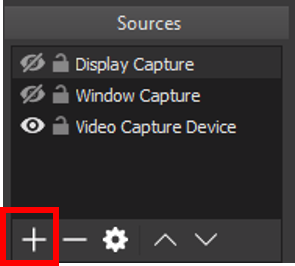

- This will generate a drop-down menu with three different choices: Display Capture, Window Capture, and Video Capture Device.
- Select “Video Capture Device” to add a camera.
- Then, you will be asked to name your video source. You can add an existing one or create a new one
- At this stage, you can also choose to flip the image vertically or horizontally, adjust the opacity, change the resolution, or set up a chroma-key (green screen) effect.
- When you are done, click “OK,” and your video source will be added.
If there is a blank space bordering your video feed, you may need to go to “Settings” and adjust the resolution of your broadcast to match the size of your video input.
Another common issue is a black screen, which can happen when OBS can’t capture certain applications or scenes. To fix this, try running OBS as an administrator, updating graphics drivers, or adjusting compatibility settings. If using game capture, ensure the game is running in full-screen mode for the best results.
Along with the video sources, OBS Studio also offers you an audio mixer you can use when dealing with multiple audio sources. It helps you mix the audio, mute it, and get greater control over your live streams.
Common audio/video sync problems happen due to improper settings or conflicting devices. To fix this, check the audio buffer settings and ensure that both audio and video sources are properly synchronized in OBS’s settings.
How to Use OBS Studio Window Capture
If you want to share your computer screen during your broadcast, you can either use Display or OBS Window Capture. Let’s go over how to use window capture.
Display Capture will broadcast everything in a certain area of your computer screen, although you can change and adjust the size of that area. Window Capture for OBS will allow you to broadcast the screen of a particular application (Skype, Word, PowerPoint, Internet Browsers, etc.) and only that.
Here’s how to set up a Display Capture:
- Go to the “Sources” widget, click on the “+” sign, and select “Display Capture.”
- Give it a name and click “OK.”
From there, you can choose whether you want the mouse cursor to be captured or not. You can also set the opacity and select a “Sub-Region” to create a smaller area of your monitor screen to capture:
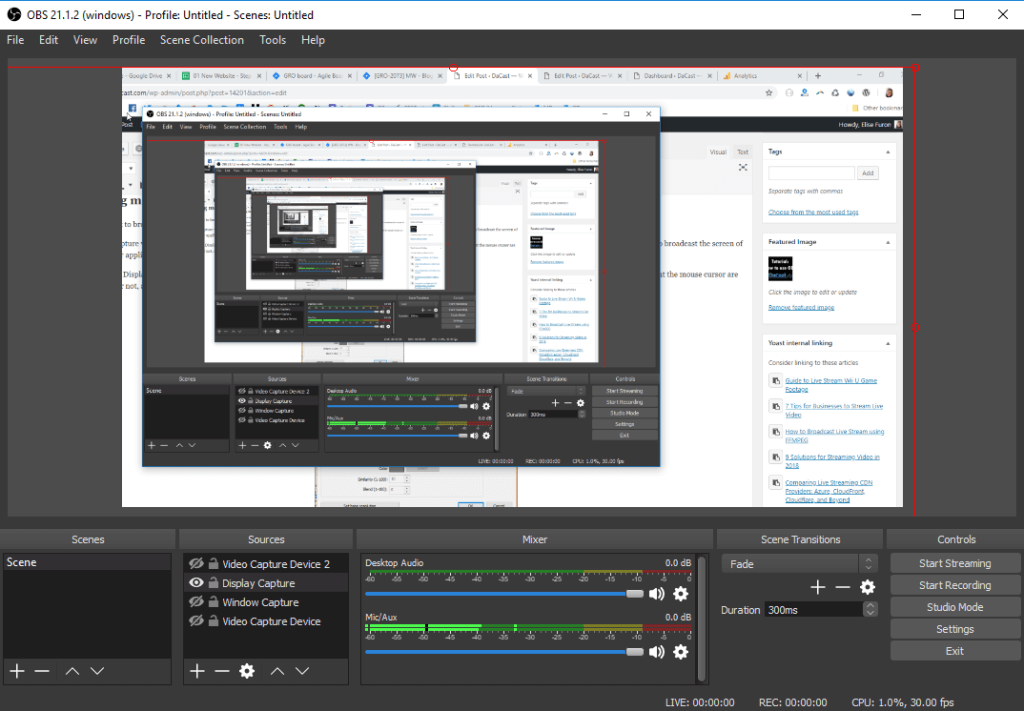

- For Windows Capture, go to the “Sources” widget, click on the “+” sign, and select “Window Capture.”
- Name the source and click “OK.”
- Select which application you want to use for OBS Window Capture from the drop-down menu. If you don’t see the one you wanted, try re-launching OBS or the program (or both). If it still doesn’t appear, use “Monitor Capture” instead.
- Choose whether you want to capture the Entire Screen or the Inner Screen. You can choose if the mouse cursor is captured or not, the opacity, and create a smaller sub-region.
- Click “OK” when you’re done.
This is how you record a window on OBS and get it to show your screen when recording a video.
How to Add Images or Text with OBS Studio
You can also use OBS to make your streams more visually interesting and engaging by adding fun graphics, images, and even text. So, how can you add those things to your OBS streaming setup? The process is fairly simple. Here’s what you need to do to add images:
- Right-click under sources, then click “Add.”
- Select and click on “Image.”
- Browse for the image you want to add and adjust the opacity.
- Select several individual files or an entire folder to add an image slideshow.
The process of adding text to your OBS stream is very similar.
- Go to “Sources” and press “+.”
- Click on “Text (GDI+).”
- Create a new source or add an existing one.
- Click “Select Font” to choose the color, style, and size.
- Add the text in the text box.
- Once done, click on OK.
- Drag and drop the text box where you want it on the screen.
Using the menu settings, you can choose the color, opacity, font, size, and message. Also, you can indicate whether or not you want the text to scroll, and you can set the scroll speed.
How to Arrange Multiple Video Sources on OBS Studio
OBS allows broadcasters to create scenes with more than one input on the same screen. This allows you to create professional picture-in-picture broadcasts and bring in multiple guests/videos via multiple video sources.
You can even mix the videos for a powerful post-production output. You can achieve this by adding your own stinger video files to OBS. You can also choose from numerous different and customizable transitions.
After adding a source, you can position it anywhere you like. To move a source, just click on it and resize and reposition it the way you want:
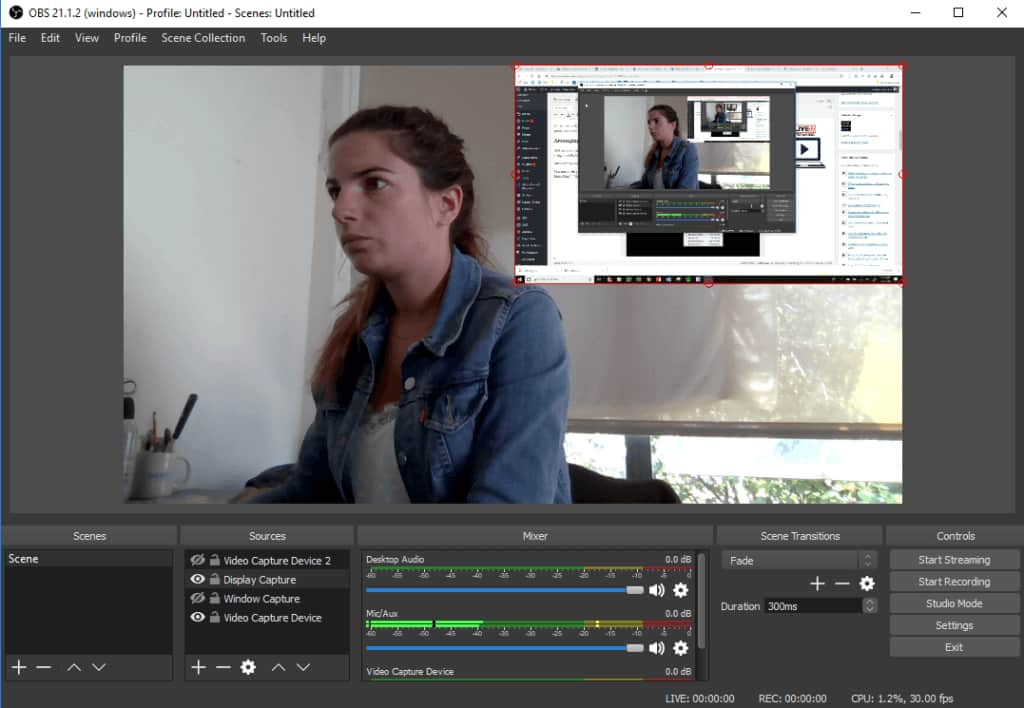

You can also right-click on your video source to change the order, rotate them, or even add filters.
If you want to rearrange the layering of your sources, go to “Order” and then select “Move up,” “Move Down,” “Move to Top,” or “Move to Bottom.” Whatever is on the top layer will cover the sources behind it, with the bottom layer at the back.
And what about filters? You can choose from a video, audio, or effect filter on the image. And how do you add a filter to your OBS stream? What you need to do is:
- Right-click the video source.
- Select “Filter”.
- Choose the type of filters you want to add.
Below is an example of an image blend filter and a color correction filter added to the video capture device source:


To remove anything added to your OBS Studio software – a filter, a video source, or a desktop audio source – just click the “eye” icon to mask it. For instance, after clicking on the “eye” icons of the effect filters previously added, the video source is back to its original state, as shown in the image below:
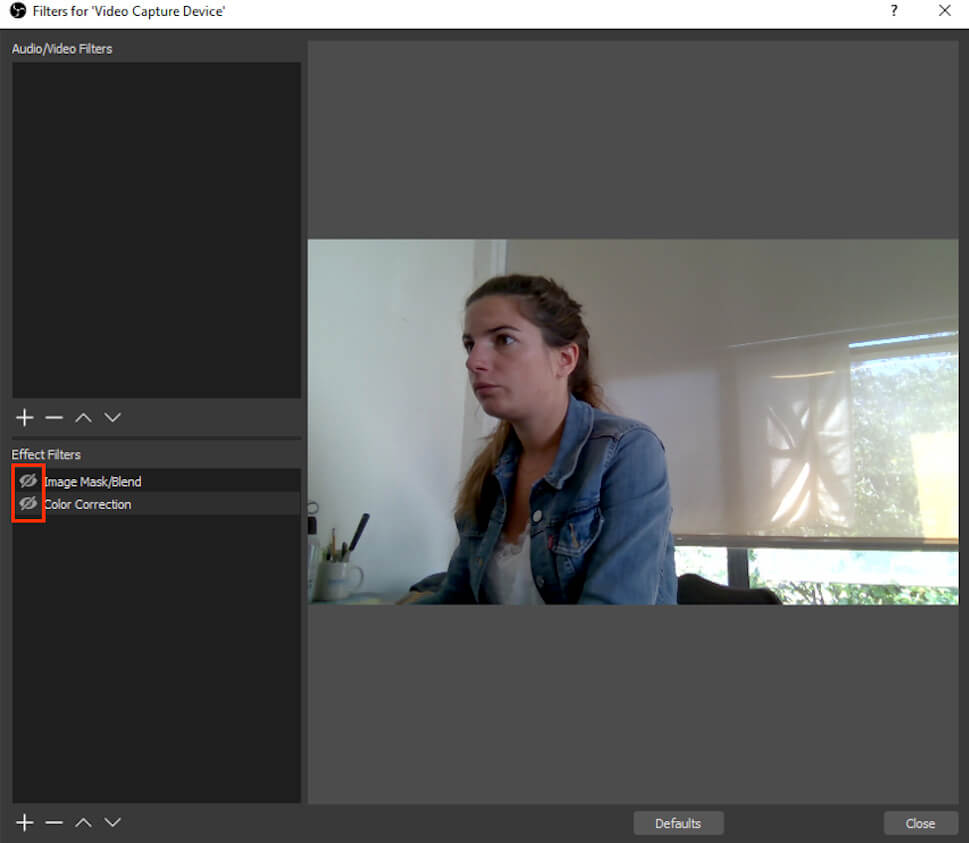

As you can see, learning how to set up OBS for streaming and customizing the layout is simple and easy.
And the best part about OBS Studio?
It also offers a Studio Mode. When you activate this mode, you can preview your scenes from the sources before you go ahead and live stream them. This helps you avoid any untoward incident where a poor-quality broadcast gets live-streamed to your audience.
How to Set Up OBS Studio Hotkeys
Ever wonder how professional streamers seamlessly transition from one screen to another in the blink of an eye? The answer is: hotkeys! Hotkeys are a “key” feature (pun intended) of OBS Studio that will take your streams to the next level.
Setting up hotkeys allows you to switch between multiple scenes instantly at the touch of a button. For example, if you have ever used CTRL+C to copy something on your computer, you have used a hotkey.
In OBS, using hotkeys allows for smooth, precisely timed cuts between different pre-recorded or live video streams. So how do you use them?
To use the hotkeys, start by creating another scene by clicking on the “+” within the “Scene” widget:
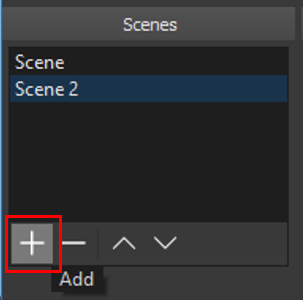

You can set up hotkeys to switch between video streams, use filters, and other important functions. OBS has some basic commands already established as hotkeys, such as:
- Copy source Ctrl+C
- Past source Ctrl+V
- Remove source Del
- Fit to screen Ctrl+F
- Stretch to screen Ctrl+S
- Center to screen Ctrl+D
This will make it easier to learn how to stream on OBS and create engaging broadcasts.
Recommended OBS Bitrate Settings
Here are the recommended OBS Studio settings for various ingestion resolutions, including SD (Standard Definition), LD (Low Definition), and ULD (Ultra Low Definition) alongside HD and QHD.
1. Ultra Low Definition (ULD) – 240p
- Resolution: 426 × 240
- Bitrate: 300–700 Kbps (streaming) / 2,000+ Kbps (recording)
- Frame Rate: 24 or 30 FPS
- Encoder: x264 (CPU) or NVENC/AMD (GPU)
- H.264 Profile: Baseline
- Audio Bitrate: 64 Kbps
2. Low Definition (LD) – 360p
- Resolution: 640 × 360
- Bitrate: 500–1,200 Kbps (streaming) / 3,000+ Kbps (recording)
- Frame Rate: 24, 30, or 60 FPS (depending on stability)
- Encoder: x264 (CPU) or NVENC/AMD (GPU)
- H.264 Profile: Baseline or Main
- Audio Bitrate: 96 Kbps
3. Standard Definition (SD) – 480p
- Resolution: 854 × 480 (or 720 × 480 for 4:3 aspect ratio)
- Bitrate: 1,200–2,500 Kbps (streaming) / 5,000+ Kbps (recording)
- Frame Rate: 30 FPS (recommended) or 60 FPS (if bandwidth allows)
- Encoder: x264 (CPU) or NVENC/AMD (GPU)
- H.264 Profile: Main
- Audio Bitrate: 128 Kbps
4. High Definition (HD) – 720p
- Resolution: 1280 × 720
- Bitrate: 2,500–5,000 Kbps (streaming) / 10,000+ Kbps (recording)
- Frame Rate: 30 FPS (standard) or 60 FPS (smoother motion)
- Encoder: x264 or NVENC/AMD (if using a GPU)
- H.264 Profile: Main or High
- Audio Bitrate: 160 Kbps (standard) or 320 Kbps (high quality)
5. Full HD (FHD) – 1080p
- Resolution: 1920 × 1080
- Bitrate: 4,500–9,000 Kbps (streaming) / 20,000–50,000 Kbps (recording)
- Frame Rate: 30 FPS (standard) or 60 FPS (if bandwidth allows)
- Encoder: x264 (CPU) or NVENC/AMD (GPU)
- H.264 Profile: High
- Audio Bitrate: 160–320 Kbps
6. Quad HD (QHD) – 1440p
- Resolution: 2560 × 1440
- Bitrate: 8,000–16,000 Kbps (streaming) / 30,000–50,000 Kbps (recording)
- Frame Rate: 30 FPS (recommended for stability) or 60 FPS (if bandwidth allows)
- Encoder: NVENC, AMD, or x264 (if CPU can handle it)
- H.264 Profile: High
- Audio Bitrate: 320 Kbps
Here is a summary of the best OBS bitrate settings in a table format:
| ULD | LD | SD | HD | FHD | QHD | |
| Resolution | Ultra-Low Definition | Low Definition | Standard Definition | High Definition | Full High Definition | Quad High Definition |
| Ingestion Resolution | 240p | 360p | 480p | 720p | 1080p | 1440p |
| Video Bitrate (Kbps) | 300 – 700 | 500 – 1200 | 1200 – 2500 | 2500 – 5000 | 4500 – 9000 | 8000 – 16000 |
| Frame Rate (FPS) | 24 or 30 | 24, 30 or 60 | 30 or 60 | 30 or 60 | 30 or 60 | 60 FPS |
| Width (px) | 426 | 640 | 854 | 1280 | 1920 | 2560 |
| Height (px) | 240 | 360 | 480 | 720 | 1080 | 1440 |
| Encoder | x264 or NVENC | x264 or NVENC | x264 or NVENC / AMD | x264 or NVENC / AMD | x264 or NVENC / AMD | NVENC, AMD, or x264 |
| H.264 Profile | Main | Main | High | High | High | High |
| Audio Bitrate (Kbps) | 64 | 96 | 128 | 160 – 320 | 160 – 320 | 320 |
Choosing the Right OBS Studio Encoder Settings
Now that you’ve created your scenes and set up your video sources, you’re almost ready to begin broadcasting. OBS Studio is intuitive and easy to master, so starting a stream is just as easy as everything we’ve covered so far.
Your first move is to double-check that your encoder settings are correct. If you’re streaming on Dacast, there are a few required OBS studio settings you must apply to your OBS setup and any other encoding software you may use.
| VIDEO CODEC | H.264 (x264 may work) |
| FRAME RATE | 30 |
| KEYFRAME INTERVAL | 3 secs (or 3x frame rate) |
| SCANNING | Progressive |
| ENCODING BITRATE | Constant (CBR) |
| AUDIO CODEC | AAC |
| AUDIO BITRATE | 128 kbps |
| AUDIO CHANNELS | 2 (Stereo) |
| AUDIO SAMPLE RATE | 48 kHz (48,000 Hz) |
One frequent issue you might encounter is lag or dropped frames, often caused by an incorrect bitrate or an overloaded system. To resolve this, ensure your bitrate is appropriate for your internet speed (generally between 2,500-6,000 kbps for 1080p) and close unnecessary programs to free up system resources.
Check out our live encoder configuration post for a complete list of suggested settings to optimize your audio and video OBS streaming on Dacast.
The Right Hardware Setup For Running OBS
The hardware you’re using will have as much of an impact on streaming quality as your IBS settings configuration. You don’t always have to have the best equipment, but it does help. Here are a few hardware recommendations for three different budgets.
Budget-friendly setup for streaming at 720p:
- Intel i5 or AMD Ryzen 5 processor
- 8GB of RAM
- A mid-range graphics card like the NVIDIA GTX 1650
A mid-range setup for streaming at 1080p at 60fps:
- Intel i7 or AMD Ryzen 7 CPU
- 16GB of RAM
- A dedicated GPU like the NVIDIA GTX 1660 or RTX 2060
High-end setup for streaming at 4K or higher:
- Intel i9 or Ryzen 9 processor
- 32GB of RAM
- An RTX 3070 or 3080 GPU
How to Use OBS Studio with Dacast
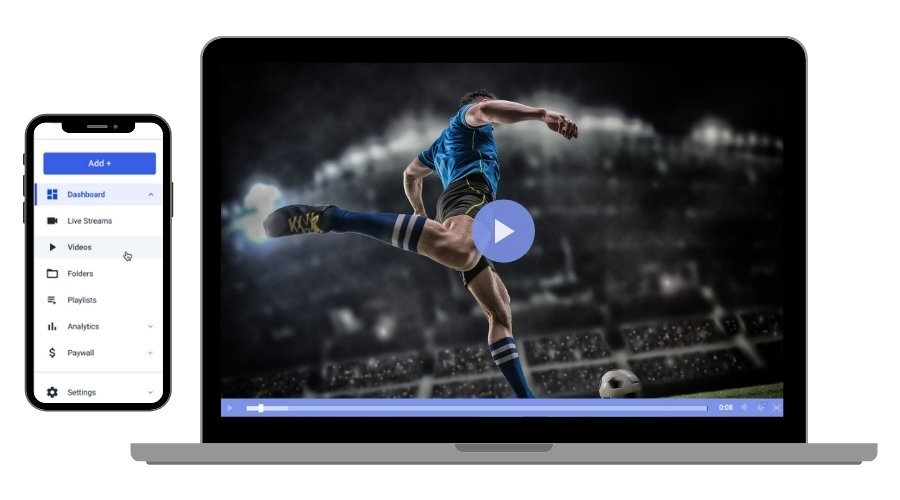

We recommend using the custom version of Dacast’s OBS Studio integration for an easy and fast setup. If you decide to use our custom version, check out this tutorial.
Before we really get into how to use OBS Studio for live streaming, let’s quickly cover how to connect your OBS Studio encoder to Dacast. This step will ensure software compatibility, so check out our post on the minimum OBS system requirements.
Launch OBS Studio:
- Go to “Settings” in the OBS Studio interface.
- You’ll see a “URL” and “Stream Key.”
- Keep these two codes handy.
Open the Dacast live streaming platform:
- Navigate to the “Encoder Setup” window and select “Generic RTMP Encoder.”
- Enter the URL and Stream Key into the fields labeled “Stream URL” and “Stream Key.”
- Select “Use Authentication.”
- Fill in “Username” and “Password” using the login information of your live channel.
From there, you should be good to livestream with OBS Studio using Dacast.
Connect OBS to Dacast:
Next, we need to connect OBS to Dacast.
- Go to OBS
- Navigate to “Settings” and select “Stream” on the left side menu.
Select “Custom Live Streaming Server“


The URL and Stream keys are available in the RTMP encoder to set up a section of your Dacast last channel.
Once you have copy-pasted the information related to your Dacast live channel, check “Use authentication.”


You will see that you need to enter a username and a password. These are the login and password of your Dacast live channel. They are available in the encoder setup section, where you find the stream URL and key. For more details on those 2 steps, you can always check this tutorial for connecting Dacast with OBS.
Finally, make sure your encoder settings are correct. For optimal results, we recommend the following:
- Resolution: match your camera/source resolution
- Frames per second: use 30 unless you have a specific reason not to
- Keyframe interval: 3 seconds
- Video codec: x264
- Bitrate: Check out our bitrate guide for multi-bitrate streaming
- Audio codec: AAC
- Channels (audio): Stereo for all streams above 360p resolution, Mono for below
- Audio sample rate: 22 kHz
Now, do a test stream to check if your broadcast looks and sounds the way you want. If it all works the way you’d hoped, you’re ready to go!
Multistreaming with OBS
While using OBS Studio by itself doesn’t allow for streaming on multiple services, integrating it with a multistreaming platform like Dacast, StreamYard, or Castr can circumvent this issue. Start by installing OBS and configuring your scenes and sources as usual. Then, sign up for a multistream service that allows simultaneous streaming to multiple platforms (like Twitch, YouTube, and Facebook).
Connect your accounts through the multistream platform’s dashboard, where you’ll get a stream key for each platform. In OBS, configure the RTMP stream settings to link with the multistream service.
Input the provided stream key into OBS’s settings under “Stream,” choosing the custom RTMP option. Once connected, OBS will stream to the multistream service, which distributes the broadcast to all linked platforms.
Integrating OBS Studio With Zoom
Another neat trick you can do with OBS is to use it alongside Zoom to stream meetings, conferences, seminars, etc. Connecting these two tools is simple and only takes a few steps. In addition to having the latest versions of OBS Studios and Zoom, what you need to do to use them simultaneously is:
- Open OBS Studio, and click the “Start Virtual Camera” in the Control section.
- Launch Zoom, head to “Settings,” go to “Video,” and select “OBS Virtual Camera.”
- Start your Zoom call, then click on the camera icon and click on “OBS Virtual Camera” to enable it.
Now you’re ready to stream or screen record everything that’s going on during your Zoom calls.
OBS Studio Video Tutorial
We recommend checking out our OBS Studio video tutorial for a visual recap of this step-by-step walkthrough of how to use OBS Studio.
Streamlabs OBS (SLOBS) vs. OBS Studio
Streamlabs OBS is another open-source software that functions similarly to OBS Studio. Both tools are great for professional broadcasters, but there are a few notable differences between them.
Streamlabs OBS has more automated features, making it easier to use. However, OBS Studio supports some more advanced functionalities.
Streamlabs OBS offers access to some premium features, such as a Streamlabs App Store, Naming Cloud Bot, extra storage, and more. It has multistream capabilities and is one of several multistreaming platforms supporting this feature. However, users can access these features only if they have a paid Prime subscription to the software.
Like OBS Studio, you can download Streamlabs OBS for free, but the Streamlabs OBS Prime membership costs $149/year or $19/month. OBS Studio is free forever, so it is certainly worth trying out.
FAQs
1. How can I optimize OBS Studio for recording high-motion content, such as sports or action videos?
Adjusting settings like increasing the frame rate and using appropriate encoding options can enhance the recording quality of high-motion content.
2. Is it possible to use OBS Studio for virtual reality (VR) streaming, and what additional setup is required?
Yes, OBS Studio can stream VR content. You’ll need to capture the VR display output and configure OBS Studio accordingly.
3. How do I integrate real-time social media feeds into my OBS Studio broadcast?
You can use browser sources or specific plugins to display live social media feeds within your OBS Studio scenes.
4. Can OBS Studio stream to multiple platforms simultaneously, and what are the methods to achieve this?
Yes, OBS Studio can stream to multiple platforms using services like restreaming platforms or by setting up multiple RTMP outputs.
5. What are the best practices for managing CPU and GPU usage while streaming with OBS Studio?
Optimizing encoder settings, adjusting output resolutions, and ensuring your hardware meets the streaming requirements can help manage resource usage.
6. How can I set up automated scene switching in OBS Studio based on specific triggers or timers?
Using scripts or plugins, you can configure OBS Studio to switch scenes automatically based on timers or other triggers.
7. What steps should I take to secure my OBS Studio streams from unauthorized access?
Implementing stream keys, using secure streaming protocols, and configuring privacy settings on streaming platforms can help secure your streams.
8. How do I troubleshoot audio-video synchronization issues in OBS Studio?
Adjusting sync offsets, checking device drivers, and ensuring consistent frame rates can resolve audio-video sync issues.
9. Is OBS free?
OBS Studio is completely free to download and use for both recording your screen and live streaming. You simply have to visit the official website to download free OBS Studio software and install it to get started.
This free software lets you capture footage from your screen, webcam, or other sources, and then customize it with scenes, transitions, and more before recording it to a file or streaming it live to platforms like Twitch or YouTube.
10. How do you live stream on Kick with OBS?
Check out our ultimate guide on how to stream on kick with OBS, where we’ll walk you through everything you need to know to get started on Kick using OBS.
Conclusion
Everything here can be used to set up your streaming software and work seamlessly with OBS Studio. Without a doubt, OBS Studio has a lot to offer. We recommend running a test stream first to ensure your broadcast looks and sounds professional.
To give your audience an even better viewing experience, you can integrate your Dacast with OBS for live streaming videos on your website. You get the ultimate streaming combination with OBS Studios’ rich array of features and Dacast’s professional-grade dedicated streaming platform. Together, they will help you stream the best live video from your website possible.
If the idea of having a professional, dedicated and white-label compatible streaming platform appeals to use, try Dacast. Dacast has all the features you need to run the highest-quality broadcasts. It’s quick and easy to set up. Sign up today for a 14-day trial to test out all of our features for free. No credit card is required.
For regular live streaming tips and exclusive offers, join the Dacast LinkedIn group.

 Connect
Connect
 Events
Events Business
Business Organizations
Organizations Entertainment and Media
Entertainment and Media API
API Tools
Tools Learning Center
Learning Center Support
Support Support Articles
Support Articles